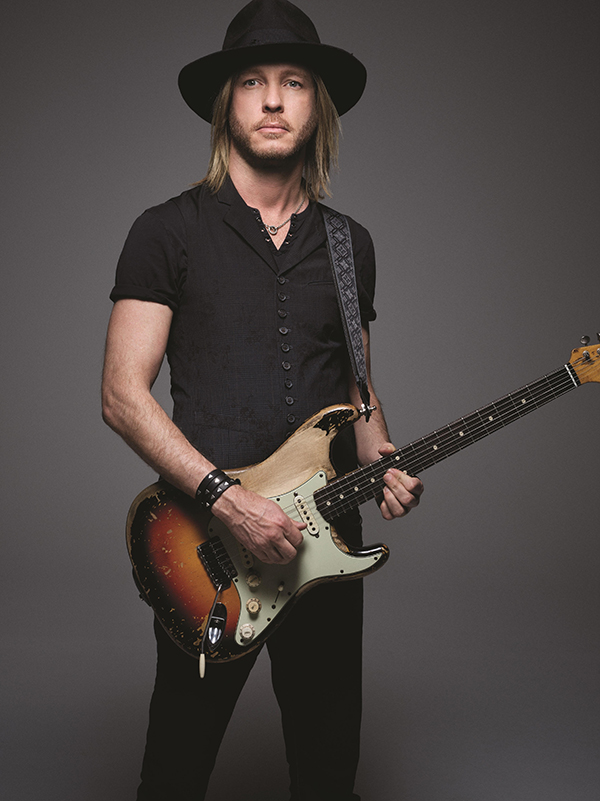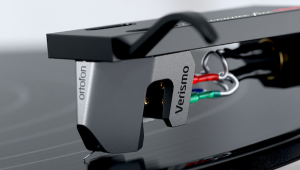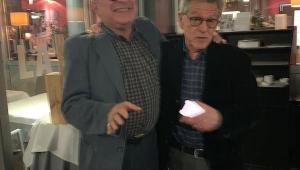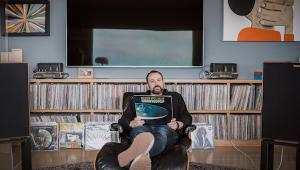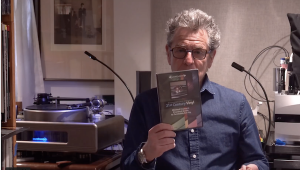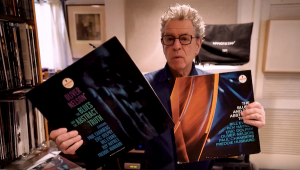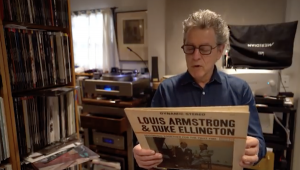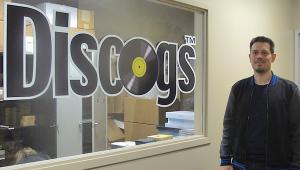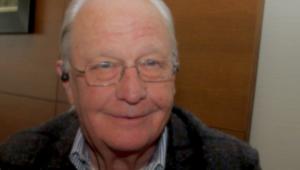Kenny Wayne Shepherd Riffs and Rolls His Way Into Some Good Ol’ Sonic Double Trouble on Vinyl With the Debut 180g 2LP Edition of Trouble Is… 25

All KWS photos in this story by Mark Seliger.
Kenny Wayne Shepherd, the pre-eminent teenage guitar phenom of the 1990s, is essentially all grown up now at age 45, but he’s still a kid at heart, albeit with a lifetime of playing his signature blend of blues, rock, and soul well under his belt. What better way to bridge the gap between the gunslinging days of yore with the wizened experience level of the here and now than with Trouble Is… 25 (Provogue), a complete re-recording of the Kenny Wayne Shepherd Band’s platinum-selling sophomore album Trouble Is…, which was originally released in October 1997 on CD and cassette, but never on vinyl.
That fact has essentially been rectified to a certain asterisked degree with Trouble Is… 25, which has been officially released today, December 2, in fine 180g 2LP form. The pressings stats for the albums are these: the vinyl is pressed at MPO in France. Bob Ludwig did the vinyl mastering, and Jeff Powell at Take Out Vinyl did the vinyl cutting and the lacquers.
I say “asterisked form” above because the entirety of Trouble Is… has been wholly re-cut here in 2022 with almost the exact same personnel who recorded the 1997-released version. Longtime KWS band associate Kevin McCormick has taken over the bass duties originally handled by Tommy Shannon, who is now retired, while vocalist Noah Hunt, drummer Chris Layton, and keyboardist Reese Wynans have all returned for Round 2. With the original album’s Record Plant locale long-shuttered, recording for 25 instead took place mainly at Village Recording in Los Angeles, with additional recording at Oceanway in Nashville.
The original arrangements of perennial Trouble Is… favorites like “Blue on Black” and “Slow Ride” have been followed quite respectfully, yet clearly updated with the vigor and passion inherent to songs that have lived and breathed and been performed during a quarter-century of KWS setlists in the interim. Plus, a cover of Bob Dylan’s “Ballad of a Thin Man,” left unfinished during the original recording sessions, has received a proper guitar-fueled update, and is now included as a bonus track to closeout Side D.

The 180g 2LP black vinyl set for Trouble Is… 25 retails for $34.99 at most shops, though Shepherd’s own official site also offers a color variant, signed editions, and deluxe versions to boot.
“We’ve been doing that for a long time,” Shepherd explains. “I’m an old school kind of guy anyway, since I grew up listening to vinyl — so, yeah, we do color vinyl, and we do regular vinyl. We know some collectors like to have the color vinyl. I remember having yellow vinyl when I was a kid, and I know how cool that is for some people.”
Shepherd, 45, and I got onto Zoom together to discuss how his dad first introduced him to vinyl, how sitting on an amplifier at a Stevie Ray Vaughan concert was a “defining moment” in his life, what the re-recording process for Trouble Is… entailed, and how mindful he is of sequencing his albums for vinyl playback. It’s an open road / Let’s see how far it goes. . .
Mike Mettler: You’ve often talked about how, when you first started learning to play guitar as a kid, you had headphones on and were listening to your dad’s CDs while you were doing it. But you also listened to vinyl in those days too, right? Tell me about some of the records you had in the house.
Kenny Wayne Shepherd: Oh yeah, yeah! We had everything. My dad had a massive vinyl collection. He used to play vinyl on the radio back in the day, you know? [KWS’s dad, “Shotgun” Ken Shepherd, could be heard back in the day as a DJ on KWKH 1130 AM in Shreveport, Louisiana.]
I had a record player, and I had a whole collection of my own of little 45 singles that he would give me — the ones they would always send to his radio station. I had a nice collection of 45s and he had a big collection of LPs, and I would just go through all of it and play that stuff. I used to sit with a tape recorder and my little record player, and I would record myself hosting my own radio show.
Mettler: Oh, nice. Do you have any tapes of you doing your show saved anywhere?
KWS: They’re probably, likely somewhere, but digging them up would be a challenge. (chuckles) I’m sure they’re around.
Mettler: That would be a nice little Easter egg bonus you could throw on at the end of your next archival release. (laughs) What do you play your vinyl on these days?
KWS: We have a few different turntables here, but my buddy just got me a really nice vintage refurbished one from the ’70s, a Technics. [MM adds: He did not have the specific model number offhand.]
Mettler: Excellent choice. Tell me what specific 45s you remember playing as a kid. Did you play them on one of those typical, self-contained, suitcase 45 players?
KWS: Yeah, exactly — the one with the lid. At the time, my dad was working on country radio, so I was spinning things like “Islands in the Stream” by Dolly Parton and Kenny Rogers, and things like that. [Released as a single on RCA Nashville in May 1983, “Islands in the Stream” reached No. 1 on the Billboard Hot 100, Hot Country Songs, and Adult Contemporary charts.]
I was a big Dallas Cowboys fan, and the quarterback at the time was Danny White. He retired from football, and then he went on to try having a music career, so I had Danny White’s 45 single. I mean, I had all kinds of random stuff. [White’s only single, “You’re a Part of Me,” a duet with Linda Nail, was released in 1983 as a 45 on the Grand Prix label, and it only made it to No. 85 on the Hot Country Songs chart.]
Mettler: Besides the 45s, you must have also had some vintage Chess records and Muddy Waters or John Lee Hooker albums in the collection, right?
KWS: Oh yeah, man — we had all that! That was right around the time they started reissuing all that stuff on vinyl. We’d get the Chess box sets and the stuff on Alligator Records, and some other labels. We had all kinds of amazing stuff. That was a real kind of heyday for people going back and digging up the original masters from all those blues recordings and putting them out on compact disc for the first time too — but my dad also had that big album collection.
Mettler: Do you have a favorite record to play on vinyl, one that’s your Holy Grail vinyl record?
KWS: My favorite record to put on and play, to this day, is the ZZ Top Fandango! album [released in April 1975 on London Records]. I used to put it on the record player, crank up the volume, and just play air guitar jumping up and down in front my grandfather’s bed. (MM laughs) Half the album is live tracks and half of it is studio stuff, and it just gives you both experiences on one album. And it sounds killer.
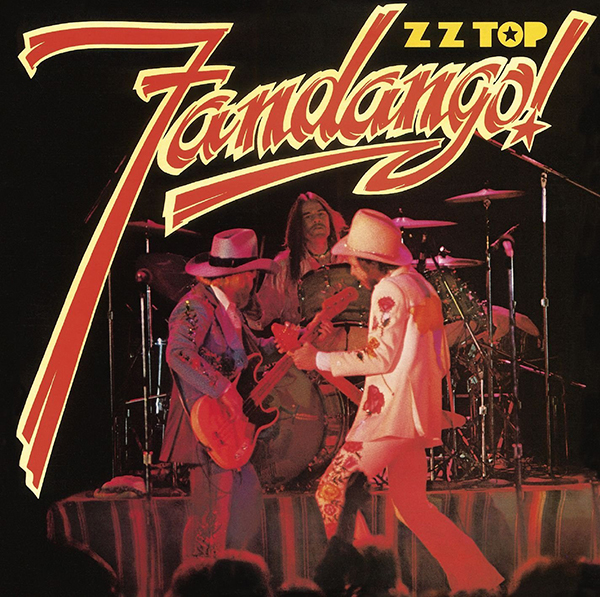
Mettler: Yeah, I agree. It’s one of my favorites too. Originally, I only had used copies of Fandango! and [ZZ Top’s July 1973 London Records LP] Tres Hombres, and I wore them both out because I overplayed them — so I’m glad I was finally able to get fresh, new copies of both of them later on. Billy Gibbons loves vinyl too, of course — but I don’t have to tell you that. (laughs)
KWS: I had multiple formats — I had cassettes, I had CDs, and I had vinyl LPs. That’s all the stuff I used to listen to the music as I was trying to learn how to play the instrument [i.e., the guitar].
Mettler: A lot of guitar players have talked about how they would take their 45s and slow ’em down to 33, or even 16, so they could hear the solos and try to figure them out. Did you wind up doing anything like that, or did you just play everything in real time?
KWS: No, no — I did a little bit of both, but a lot of the times, the most tedious part was trying to learn from the cassettes because you’d have to play and stop and rewind, and then play and then stop and rewind again.
The record thing always was a challenge. Slowing down a record affects the pitch, and your guitar wasn’t really in tune with it. That kind of messed with me, because when things are out of tune, it makes me really uncomfortable. (laughs) So, that made it challenging.
Mettler: At that early an age, did you already know things were out of out of whack when you’d listen to music that way? Was your ear already attuned to the point of, “I know when something sounds right, or when something sounds off”?
KWS: I feel like — I’m pretty sure I have perfect pitch, or close to it. I feel like that’s something you’re born with, and I feel like you can probably cultivate it as well. But I know I always heard things differently, even as a child. I just think I was always in touch with that, even if I wasn’t actually aware of what it was yet.
Mettler: I get that. The first concert your dad took you to see was with Muddy Waters and John Lee Hooker, when you were either three or four years old — could you tell, “This is what my thing is,” or was it just too early to know that?
KWS: In all honesty, I don’t have a vivid memory of that. I was so young. But it had to have planted a seed in me as a kid. I mean, I can’t imagine anybody going to see Muddy Waters and John Lee Hooker and it not affecting them in some way, right?
Looking at how my life has played out, and the trajectory and the influence that blues music ended up having on me and my guitar playing, it only seems natural that if you connect the dots backwards from now and go back to that point, you go, “This had to have had an impact.”

Mettler: Yeah, there’s no question about that. I mean, right from your first album [September 1995’s] Ledbetter Heights, you’re already laying down the gauntlet with the title alone. At that time, though, I think it wasn’t as easy for people to look up what that title referred to. If you didn’t know that was a Lead Belly reference, and also to a very specific physical location near where you, and he, grew up in Shreveport, Louisiana, people might have even thought you were referring to Led Zeppelin, or something. But I feel like right from the start, you said, “I’m gonna be authentic. I’m gonna play from my heart.” And that’s how it came at us, right out of the box.
KWS: Yeah. I’ve always acknowledged the people who inspired me to do what I do, and given credit where credit is due — which is the tradition, in this kind of music. But, yeah, without a doubt, my roots are firmly planted in blues music. You can listen to my body of material, and it doesn’t take long to figure out that I certainly like to take it into different directions, you know?
Mettler: That’s for sure. And if you don’t mind, I’d like to go back to September 2, 1984, when you’re sitting on the amplifier at the Stevie Ray Vaughan show [at Veterans Park in Shreveport]. You’re like, what, seven or eight there? Are you more cognizant then of having that sense of, “This is what I wanna do”? Is that stamped in your mind as what you felt at that moment?
KWS: Well, I think it was a defining moment for me. I think that, watching him [SRV] play — I’m aware of the effect his playing had on me, because I saw him several times after that, and every time, I had the same experience. It was just a definitive moment for me, for sure. That really lit the fire inside me to want to play guitar. I wanted to learn how to play with that passion, and that intensity.
Mettler: That, to me, is a perfect segue into what Trouble Is… as a record, the original 1997 version. As soon as you cue it up, you feel what that passion is, coming from you as the player — and that had to be your goal. When you were in pre-pro mode with Jerry [Harrison, the album’s producer], did you say, “This is what we have to capture here”? Tell me what that process was.
KWS: Well, I’m sure Jerry knew that already. Jerry had come and seen me perform, prior to going in the studio. Everybody knew it was really about the live performance. For me, it’s always been about the live performance. We make great records, but we make even better live concerts. And so, trying to capture that is the essence of what we do best, and what I do best. I think that’s always been the goal from Day 1 — capture that live performance vibe on the record and not make it sound contrived, and just make it sound authentic and real, like it’s going down right then and right there.
At the time, I’m like 18 years old, and there’s that youth and that energy in all of that as well. I just knew I had an opportunity to really stake my claim and plant my flag in the soil and say, “I’m here to stay, with this second record.” And we certainly did that. [Trouble Is… has been long-certified as platinum by the RIAA — as in, 1 million copies sold — so that would indeed appear to be the case.]
Mettler: Was there one track that was the “light bulb track” in the recording process where you were like, “Yeah, we’ve got it”?
KWS: Well, “Blue on Black” certainly was like that. Everybody thought it was special. We didn’t know how big it was going to become. [“Blue on Black” topped the Mainstream Rock Tracks chart at the time, and it reached No. 78 on the Billboard Hot 100 singles chart as well.]
KWS: There are a lot of moments on this record. “Slow Ride” is a song that really captures the raw energy of the band, and so do “True Lies” and “King’s Highway.” I mean, there are just a number of them I feel really represent the sound and the energy I wanted to convey through the music.
Mettler: The sequencing also tells story, to me. I feel like “Slow Ride” is the classic, album opening, barn burning, we’re coming out of the gate track. And then I like having “Blue on Black” in the third position, because that shifts the mood a little bit, and then you go into [Bob] Dylan right after that with “Everything Is Broken,” and then comes Jimi [Hendrix] — which I feel is just the right choice, to go with that “I Don’t Live Today” vibe there. Of all the Jimi Hendrix tracks you could have chosen at that time, that’s maybe an unexpected one to go there. Was that the idea?
KWS: Well, yes. That’s always the idea when I choose cover songs. For the most part, we usually like to choose — you know, when everybody thinks Jimi Hendrix, they think “Voodoo Child” or “Purple Haze,” and so forth. So we go, “Well, let’s do this one, because they won’t be thinking of that,” you know what I mean? And so, historically, when I cover a song, I like to dig deeper into people’s catalogs, and get the not-quite-so-obvious song to do.
Mettler: I think that’s cool, because when you’re known as being “the guitar guy,” you’re almost expected to do this, or this, or this — and you don’t do that. You never go to the likely, “obvious” choice. I also found it interesting when you guys were talking about “Ballad of a Thin Man” toward the end of the documentary [on DVD included in the CD+DVD set]. I actually love that version, and I know you had to go back and put guitar on it since you never finished it back in the day. When you say you didn’t want it on the record at first, was it because you already had the other Dylan cover on there, “Everything Is Broken”? You didn’t wanna have two Dylan songs on the album, is that right?
KWS: Yeah, we couldn’t have two Bob Dylan songs on one record (chuckles), unless we were gonna do an entire Bob Dylan tribute album. We had to choose which one to go with — and, to me, “Everything Is Broken” felt “safer,” because it felt more in the blues box, if you will.
KWS: “Ballad of a Thin Man” felt like a real departure — which, at the time, maybe I was playing it a little safe, and Jerry was trying to push me outside the comfort zone and add a little more depth to the overall sound of the record by doing a song like that. In retrospect, I think “Everything Is Broken” was a great choice for the record, but now that we have re-recorded the Trouble Is… album, we’ve decided to include “Ballad of a Thin Man” — so it ended up making the record anyway, you know?
Mettler: “Ballad of a Thin Man” is yet again one of those Dylan songs that, many decades later, still says something about the current state of the world. It goes to show great songwriting doesn’t have a timeline on it. It can be forever relevant.
KWS: Yeah, for sure — and that’s always been my goal as an artist, is to write timeless music as well, and I think we’ve accomplished that. I mean, just the idea that people are still interested in all these songs, 25 years later — or [almost] 30 years later, if you go back to the first album [the aforementioned 1995 release, Ledbetter Heights] — I think we’ve accomplished that, for sure.
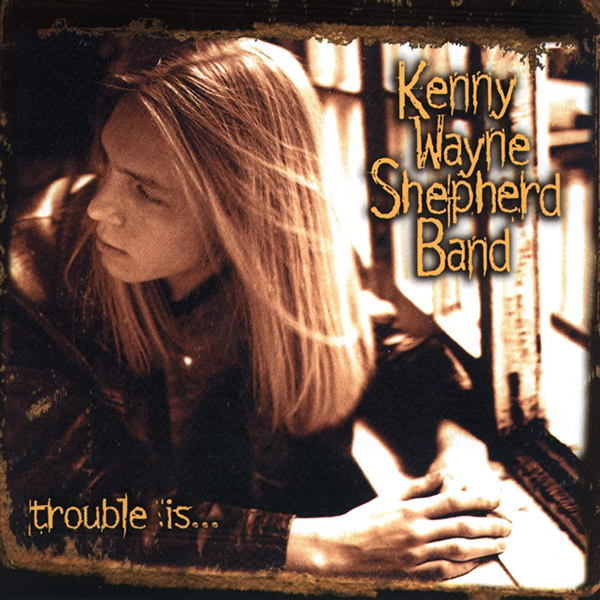
Mettler: Agreed. What I also like about Trouble Is…25 on vinyl is the original album ran for about 65 minutes on CD, so you couldn’t have put it on a single LP disc anyway. Did you have to think about side breaks differently, since it’s essentially a double record now?
KWS: Oh, obviously, yeah. Thankfully, we didn’t have to change the track listing, so we just needed to make it a double LP in order to fit it all. Sometimes, on certain albums, we’ve had to change the track listing because if you go too far with it, you start losing fidelity and you start losing output, and things like that. For this one, we just made it a double LP, and everything kind of worked out.
Mettler: And that’s the right call — because if you had tried to cram, say, five songs onto a side, by the time you’d get to Track 5, “I Don’t Live Today,” I feel like my needle would have jumped automatically out of the groove because there’s just so much going on there.
KWS: Right, right.
Mettler: Now we get to my usual last question. We’ve just talked about Trouble Is… at age 25, so let’s project to 50 years from now. We’re in 2072. Unless there’s some weird science stuff, I doubt you and I are physically on the planet at that point. For however people listen to music in 2072 and they cue up the name “Kenny Wayne Shepherd,” what do you want them to get out of that experience?
KWS: I just want them to have a great listening experience, and to feel something when they listen to the music. That’s it, really. I make music to try and make people feel something, so that’s what I want them to do.

KENNY WAYNE SHEPHERD BAND
TROUBLE IS… 25
180g 2LP (Provogue)
Side A
1. Slow Ride
2. True Lies
3. Blue On Black
Side B
1. Everything Is Broken
2. I Don’t Live Today
3. (Long) Gone
Side C
1. Somehow, Somewhere, Someway
2. I Found Love (When I Found You)
3. King’s Highway
Side D
1. Nothing To Do With Love
2. Chase The Rainbow
3. Trouble Is…
4. Ballad Of A Thin Man
